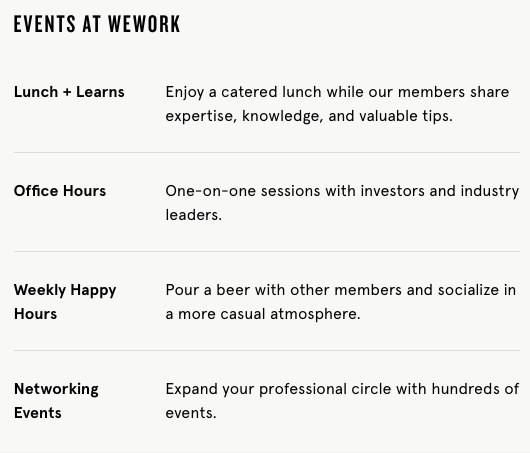Small and medium-sized coworking spaces have to deal with big multinational companies extending to more and more cities. I suggest here a mixed strategy aimed at those spaces striving to survive, and it goes beyond striving to protect the authenticity of coworking.
There is a growing interest among some coworking spaces managers to come with a definition of what coworking is and isn’t (click here and here to see some recent examples in the Spanish context).
They attempt to protect the “coworking way” and its authenticity from people who are only seeking to own the label and sell their own spaces. They emphasise the underlying philosophy of the coworking phenomenon: the importance of community and collaboration. Those two concepts boil down to the idea of sharing knowledge, connections, and other types of resources.
During this year’s Coworking Spain Conference in May, the landing of “big players” was discussed with a palpable apprehension. These are large, often multinational, companies that have invested in the business of shared offices and that are now offering “coworking”, which is the case of Spaces, Regus’ coworking brand. To a large extent, they are related with real estate brokers and backed up by financial investors. This is a support that small or medium-sized independent spaces could never dream of having.
These big players have an enormous monetisation capacity, basically due to their ability to build enormous spaces fitting an equally huge number of workers. For example, we learnt not long ago that WeWork is negotiating with the real estate company Colonial the acquisition of a 7000 square meters (75.348 square feet) offices building in Barcelona (link to a news report in Spanish).

I think that the concern raised by these big players is directly related to the unequal competition they represent, and the reaction is, very understandably, to protect that in which these managers have invested almost all of their loans.
Be different and survive as small and medium coworking spaces
In a market economy, the only way to protect small and medium businesses from the threat of large volumes is to clearly differentiate the product sold from the generic one that is sold in large amounts -or at least this is what classical economical theory dictates. In other words, small and medium businesses should be able to offer a differential value.
Small and medium-sized coworking spaces aim at defending their territory -or market segment- resorting to the value provided by communities that are created in those spaces. Seemingly, those big players wouldn’t know how to create communities because their interest so directly focus on profit.
But this isn’t necessarily true. A community of coworkers where different types of resources are shared can be achieved in many ways, and these big players have their own strategies to do it. Here’s an example taken from WeWork website:

So… what can the small and medium players do? Or better put: what is it already being done and what should be strengthened to face this reality?
Local connections
There are two basic elements in a strategy that both small and medium-sized coworking spaces can apply to build strong value propositions to face the -really- big ones.
The first element is to develop a strong connection to their contexts. What do I mean by this? I refer to the connection between the spaces and the city/neighbourhood/street where they’re located. This remains true for the case of more rural spaces. How does your space get involved in with what goes on in your city, neighbourhood or even your street?
We know that coworking spaces are a global phenomenon, but also that it’s specific to the places where they locate.
CruCowork is an example of how you can open your space outwards. It is a space mainly dedicated to designers and other creatives. It is located in Porto’s art district in a formerly depressed neighbourhood, currently regenerated -and gentrified– through the establishment of art galleries and designer shops attracting locals and tourists alike. They regularly coordinate different joint actions, such as opening exhibitions and launching collections on the same day to attract more people to their streets.
To connect with the local commercial, entrepreneurial or associative fabric contributes in the creation of a deep(er) sense of belonging. It also opens the possibility to generate a sense of commitment from the local public administrations and the entrepreneurial ecosystem who may help protect small and medium-sized coworking spaces from the bigger ones. Besides CruCowork, Cosfera in the Spanish city of Córdoba and Sinèrgics in Barcelona seek to make this local impact.
Committing to people and projects
The second element of this mixed strategy brings us to understand “community” as more than just a bunch of people interacting in an open plan space with all the goodies allowing for that interaction to happen. A community is more than just chatting, and more than just free beers and a chill-out area, right?
We are familiar with the idea that building a community of people that gathers around similar interests or needs is crucial. I am not questioning that the design of the space and its comfort are important to foster relations and exchange among coworkers. These can even be a sine qua non condition for a particular culture to emerge and this is well-known to community builders.
However, this idea can be taken even further if we provide a constant support to the projects of independent workers or small and medium entrepreneurs at their initial stages. James Layfield, manager at Central Working in London supports this idea and considers that a community is generated through a support net working at different levels, including the emotional level. Coworkers should be able to feel an authentic interest in their development and that their projects are understood and taken care of. Their success should be felt as a collective success. An example of this comes to mind and it’s the case of La Colaboradora from Zaragoza in Spain, where the sense of being supported, of giving and receiving is well-developed through strategies such as a time bank and frequent mentorships.
This multilevel support also generates a sense of belonging. And let me tell you, even digital nomads who stay for short periods of time in one place need to feel they belong.
Summing up, the particular connection to the local reality and a holistic commitment to caring and supporting both the people and their projects is what makes the idea of coworking and of a community reach the next level. I am sure there are tons of examples of coworking spaces that are already implementing this strategy. Tell us about them below!
Don’t forget to suscribe to my mailing list below to get fresh content once a week.
Click here to learn more about what I do and why I do it.